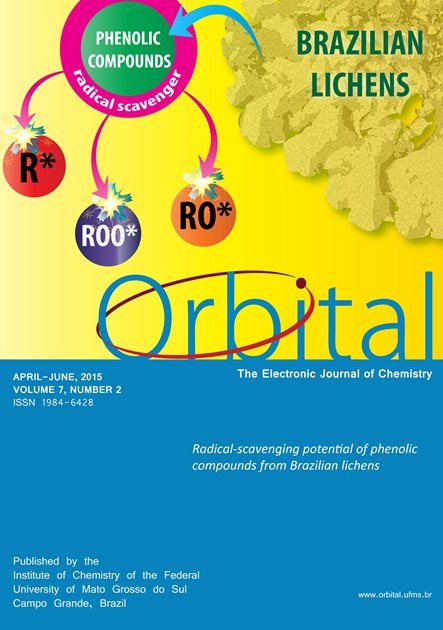- lichens,
- scavenging activity,
- phenolic compounds,
- DPPH concentration
Copyright (c) 2015 Orbital: The Electronic Journal of Chemistry

This work is licensed under a Creative Commons Attribution-NonCommercial-NoDerivatives 4.0 International License.
Abstract
Lichens produce a wide range of phenolic substances, mostly depsides and depsidones. As part of our ongoing study of lichens from the Cerrado biome in Mato Grosso do Sul state, the present article reports novel findings on the radical-scavenging activity of two depsides, five depsidones, usnic acid, and lichexanthone that were evaluated against 0.1 and 0.3 mM 2,2’-diphenyl-1-picrylhydrazyl radical concentrations. These substances were isolated from the lichens Parmotrema tinctorum (Nyl.) Hale, Parmotrema dilatatum (Vain.) Hale, Pseudoparmelia sphaerospora (Nyl.) Hale, Parmotrema lichexanthonicum Eliasaro & Adler, Ramalina anceps Nyl. Usnea subcomosa Vain. and Usnea jamaicensis Ach. Usnic acid (EC50 = 3.34 ± 1.44 and 5.97 ± 1.91 mM, respectively) and atranorin (2.48 ± 1.18 and 10.10 ± 1.18 mM, respectively) proved the most active unmodified compounds. Lecanoric and protocetraric acids exhibited significant EC50 differences between DPPH concentrations. Besides these, nine 9’-O-alkyl protocetraric acid derivatives were also evaluated. 9’-O-methyl protocetraric and 9’-O-iso-propyl protocetraric acids (with respective EC50 values of 1.74 ± 0.83 and 1.03 ± 1.0 mM, both against 0.1 mM DPPH) were the most active compounds evaluated. Except for 9’-O-methyl protocetraric acid, chain elongation correlated with increased scavenging activity in the linear series from 9’-O-ethyl to 9’-O-n-hexyl protocetraric acid.


